MAR042-6 Business Dissertation: Vessel Turnaround Time in Colombo Port
VerifiedAdded on 2022/11/23
|47
|14990
|74
Project
AI Summary
This business dissertation investigates the factors affecting vessel turnaround time (VTT) at the Colombo International Container Terminals (CICT) within the Port of Colombo. The research aims to assess the needs and consequences of lowering VTT, identify key influencing factors, and propose strategies for minimization. The study utilizes a cross-sectional structured interview design, collecting data through a survey questionnaire administered to 50 respondents. Data analysis employs percentage distribution, mean value distribution statistics, and correlation statistics. The findings highlight cargo transfer delays and breathing delays as major contributors to VTT, with equipment quality identified as a critical area for improvement. The dissertation provides a comprehensive analysis of the current situation, identifies underlying factors, and offers recommendations to enhance port efficiency and reduce turnaround times, ultimately contributing to improved customer satisfaction and economic benefits. The research also includes an introduction, literature review, methodology, analysis & discussion, and conclusion & recommendation chapter for a detailed study. The study also focuses on the strategic importance of Colombo Port and the issues that are caused due to delays in the East Container Terminal.
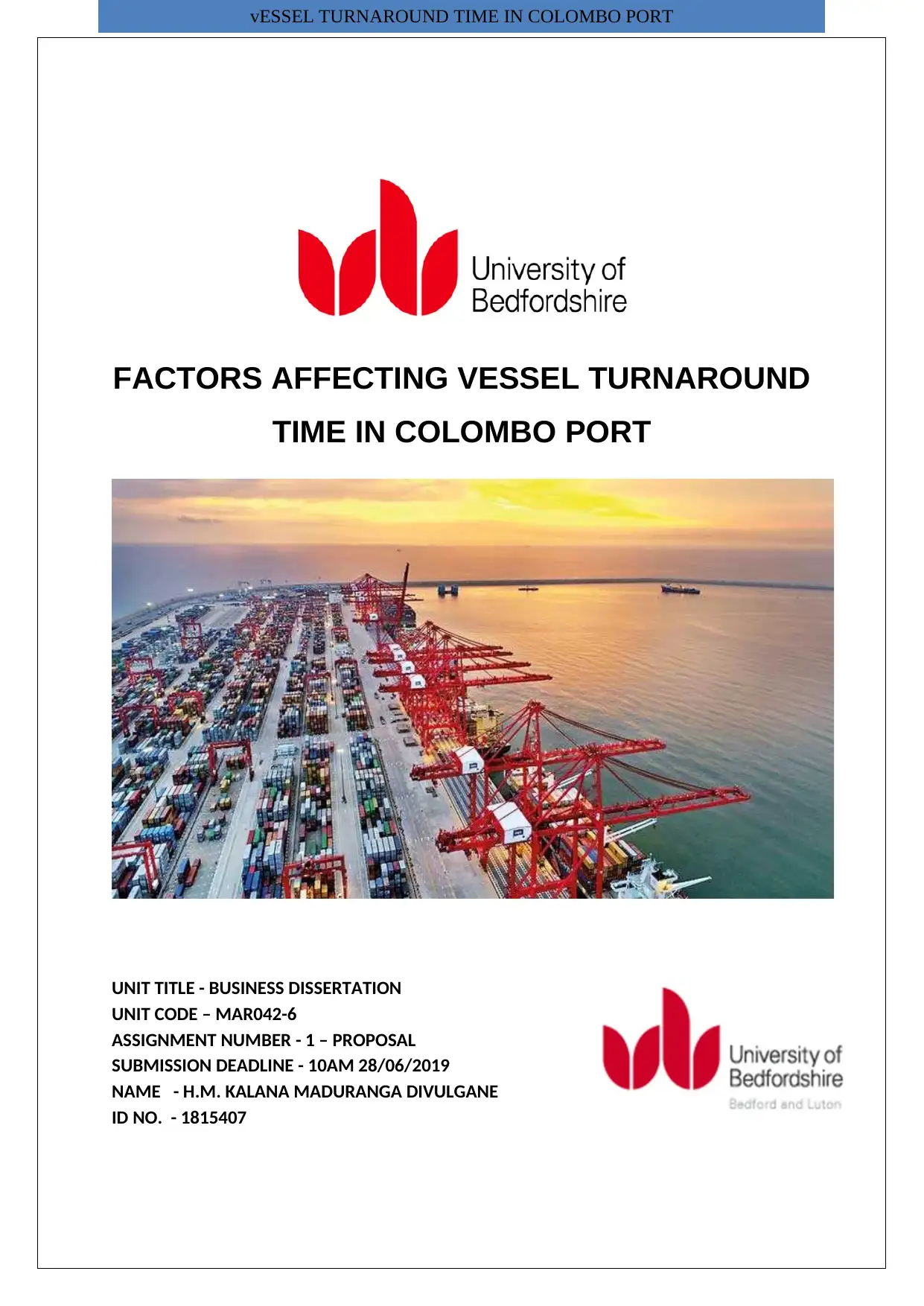
FACTORS AFFECTING VESSEL TURNAROUND
TIME IN COLOMBO PORT
UNIT TITLE - BUSINESS DISSERTATION
UNIT CODE – MAR042-6
ASSIGNMENT NUMBER - 1 – PROPOSAL
SUBMISSION DEADLINE - 10AM 28/06/2019
NAME - H.M. KALANA MADURANGA DIVULGANE
ID NO. - 1815407
vESSEL TURNAROUND TIME IN COLOMBO PORT
TIME IN COLOMBO PORT
UNIT TITLE - BUSINESS DISSERTATION
UNIT CODE – MAR042-6
ASSIGNMENT NUMBER - 1 – PROPOSAL
SUBMISSION DEADLINE - 10AM 28/06/2019
NAME - H.M. KALANA MADURANGA DIVULGANE
ID NO. - 1815407
vESSEL TURNAROUND TIME IN COLOMBO PORT
Paraphrase This Document
Need a fresh take? Get an instant paraphrase of this document with our AI Paraphraser
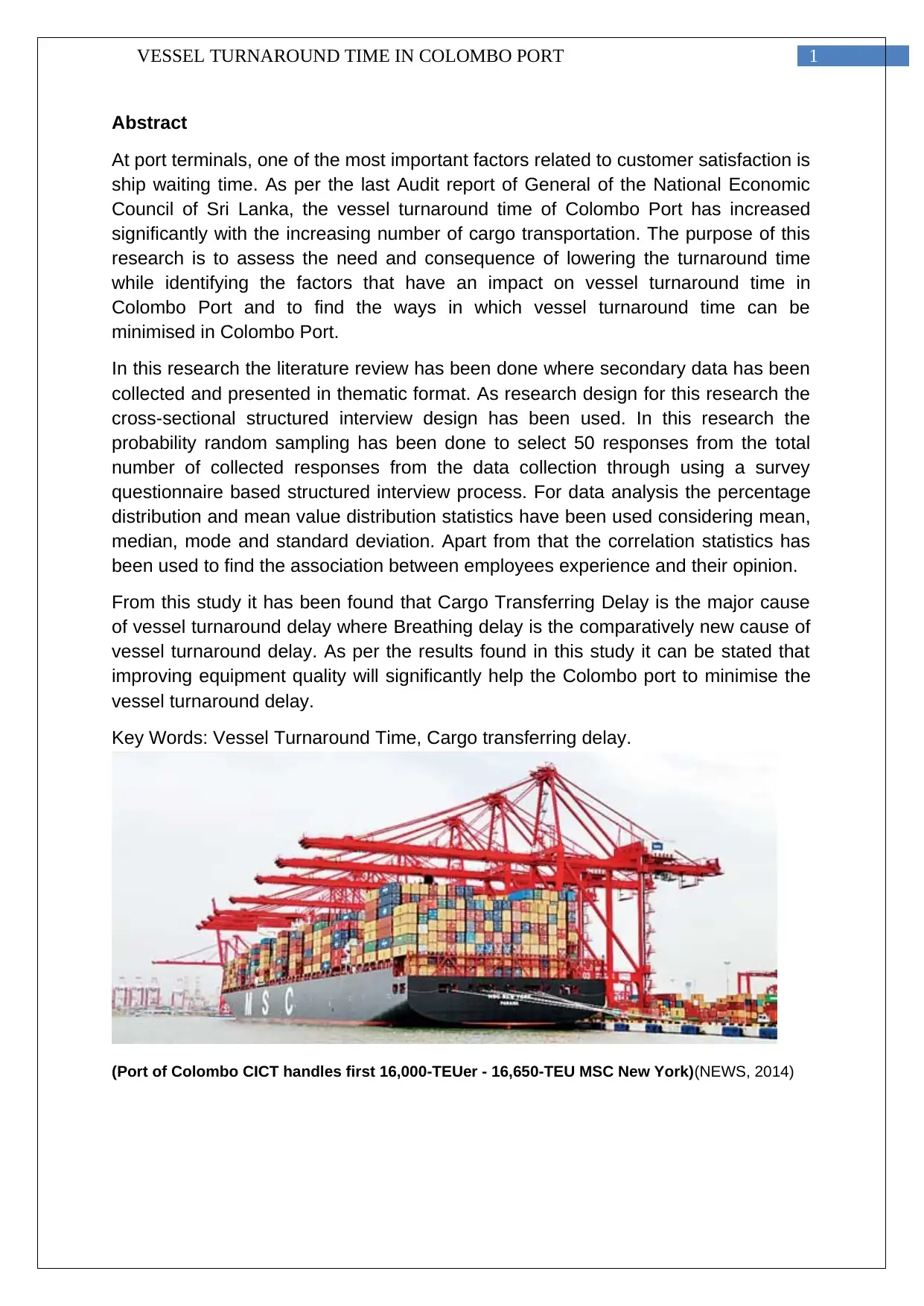
1VESSEL TURNAROUND TIME IN COLOMBO PORT
Abstract
At port terminals, one of the most important factors related to customer satisfaction is
ship waiting time. As per the last Audit report of General of the National Economic
Council of Sri Lanka, the vessel turnaround time of Colombo Port has increased
significantly with the increasing number of cargo transportation. The purpose of this
research is to assess the need and consequence of lowering the turnaround time
while identifying the factors that have an impact on vessel turnaround time in
Colombo Port and to find the ways in which vessel turnaround time can be
minimised in Colombo Port.
In this research the literature review has been done where secondary data has been
collected and presented in thematic format. As research design for this research the
cross-sectional structured interview design has been used. In this research the
probability random sampling has been done to select 50 responses from the total
number of collected responses from the data collection through using a survey
questionnaire based structured interview process. For data analysis the percentage
distribution and mean value distribution statistics have been used considering mean,
median, mode and standard deviation. Apart from that the correlation statistics has
been used to find the association between employees experience and their opinion.
From this study it has been found that Cargo Transferring Delay is the major cause
of vessel turnaround delay where Breathing delay is the comparatively new cause of
vessel turnaround delay. As per the results found in this study it can be stated that
improving equipment quality will significantly help the Colombo port to minimise the
vessel turnaround delay.
Key Words: Vessel Turnaround Time, Cargo transferring delay.
(Port of Colombo CICT handles first 16,000-TEUer - 16,650-TEU MSC New York)(NEWS, 2014)
Abstract
At port terminals, one of the most important factors related to customer satisfaction is
ship waiting time. As per the last Audit report of General of the National Economic
Council of Sri Lanka, the vessel turnaround time of Colombo Port has increased
significantly with the increasing number of cargo transportation. The purpose of this
research is to assess the need and consequence of lowering the turnaround time
while identifying the factors that have an impact on vessel turnaround time in
Colombo Port and to find the ways in which vessel turnaround time can be
minimised in Colombo Port.
In this research the literature review has been done where secondary data has been
collected and presented in thematic format. As research design for this research the
cross-sectional structured interview design has been used. In this research the
probability random sampling has been done to select 50 responses from the total
number of collected responses from the data collection through using a survey
questionnaire based structured interview process. For data analysis the percentage
distribution and mean value distribution statistics have been used considering mean,
median, mode and standard deviation. Apart from that the correlation statistics has
been used to find the association between employees experience and their opinion.
From this study it has been found that Cargo Transferring Delay is the major cause
of vessel turnaround delay where Breathing delay is the comparatively new cause of
vessel turnaround delay. As per the results found in this study it can be stated that
improving equipment quality will significantly help the Colombo port to minimise the
vessel turnaround delay.
Key Words: Vessel Turnaround Time, Cargo transferring delay.
(Port of Colombo CICT handles first 16,000-TEUer - 16,650-TEU MSC New York)(NEWS, 2014)

2VESSEL TURNAROUND TIME IN COLOMBO PORT
Table of content
Chapter1: Introduction........................................................................................................................... 5
1.1 Background................................................................................................................................. 5
1.2 Problem Statement...................................................................................................................... 7
1.3 Research questions..................................................................................................................... 8
1.4 Aims and objectives..................................................................................................................... 8
1.5 Research Structure...................................................................................................................... 9
Chapter 2: Literature review.................................................................................................................. 9
2.1 Introduction:................................................................................................................................. 9
2.2 Colombo port and trade activity.................................................................................................10
2.3 Turnaround time and its impact.................................................................................................11
2.4 Factors associated with turnaround time...................................................................................13
2.5 Porting strategies....................................................................................................................... 16
2.6 Summary................................................................................................................................... 17
2.7 Literature Gap........................................................................................................................... 18
Chapter 3: Methodology...................................................................................................................... 19
3.1 Introduction................................................................................................................................ 19
3.2 Research Philosophy................................................................................................................. 19
3.3 Research Approach................................................................................................................... 19
3.4 Research Design....................................................................................................................... 20
3.5 Target Population and sampling................................................................................................ 20
3.6 Data collection........................................................................................................................... 21
3.7 Data analysis............................................................................................................................. 21
3.8 Ethical Consideration................................................................................................................. 21
3.9 Summary................................................................................................................................... 22
Chapter 4: Analysis & discussion......................................................................................................... 23
4.1 Introduction:............................................................................................................................... 23
4.2 Demographic study.................................................................................................................... 23
4.3 Turnaround delay causes.......................................................................................................... 26
4.4 Suggestions............................................................................................................................... 30
4.5 Other factors.............................................................................................................................. 30
4.6Discussion.................................................................................................................................. 32
4.6 Summary................................................................................................................................... 34
Chapter 5: Conclusion and recommendation:......................................................................................36
5.1 Summary:.................................................................................................................................. 36
5.2 Linking with Objectives:............................................................................................................. 36
5.3 Conclusion................................................................................................................................. 37
5.4 Limitations and further research................................................................................................38
References.......................................................................................................................................... 40
Appendices.......................................................................................................................................... 43
Appendix 1: Business Dissertation Supervision Monitoring Form...................................................43
Appendix 2: Survey......................................................................................................................... 46
Table of content
Chapter1: Introduction........................................................................................................................... 5
1.1 Background................................................................................................................................. 5
1.2 Problem Statement...................................................................................................................... 7
1.3 Research questions..................................................................................................................... 8
1.4 Aims and objectives..................................................................................................................... 8
1.5 Research Structure...................................................................................................................... 9
Chapter 2: Literature review.................................................................................................................. 9
2.1 Introduction:................................................................................................................................. 9
2.2 Colombo port and trade activity.................................................................................................10
2.3 Turnaround time and its impact.................................................................................................11
2.4 Factors associated with turnaround time...................................................................................13
2.5 Porting strategies....................................................................................................................... 16
2.6 Summary................................................................................................................................... 17
2.7 Literature Gap........................................................................................................................... 18
Chapter 3: Methodology...................................................................................................................... 19
3.1 Introduction................................................................................................................................ 19
3.2 Research Philosophy................................................................................................................. 19
3.3 Research Approach................................................................................................................... 19
3.4 Research Design....................................................................................................................... 20
3.5 Target Population and sampling................................................................................................ 20
3.6 Data collection........................................................................................................................... 21
3.7 Data analysis............................................................................................................................. 21
3.8 Ethical Consideration................................................................................................................. 21
3.9 Summary................................................................................................................................... 22
Chapter 4: Analysis & discussion......................................................................................................... 23
4.1 Introduction:............................................................................................................................... 23
4.2 Demographic study.................................................................................................................... 23
4.3 Turnaround delay causes.......................................................................................................... 26
4.4 Suggestions............................................................................................................................... 30
4.5 Other factors.............................................................................................................................. 30
4.6Discussion.................................................................................................................................. 32
4.6 Summary................................................................................................................................... 34
Chapter 5: Conclusion and recommendation:......................................................................................36
5.1 Summary:.................................................................................................................................. 36
5.2 Linking with Objectives:............................................................................................................. 36
5.3 Conclusion................................................................................................................................. 37
5.4 Limitations and further research................................................................................................38
References.......................................................................................................................................... 40
Appendices.......................................................................................................................................... 43
Appendix 1: Business Dissertation Supervision Monitoring Form...................................................43
Appendix 2: Survey......................................................................................................................... 46
⊘ This is a preview!⊘
Do you want full access?
Subscribe today to unlock all pages.

Trusted by 1+ million students worldwide
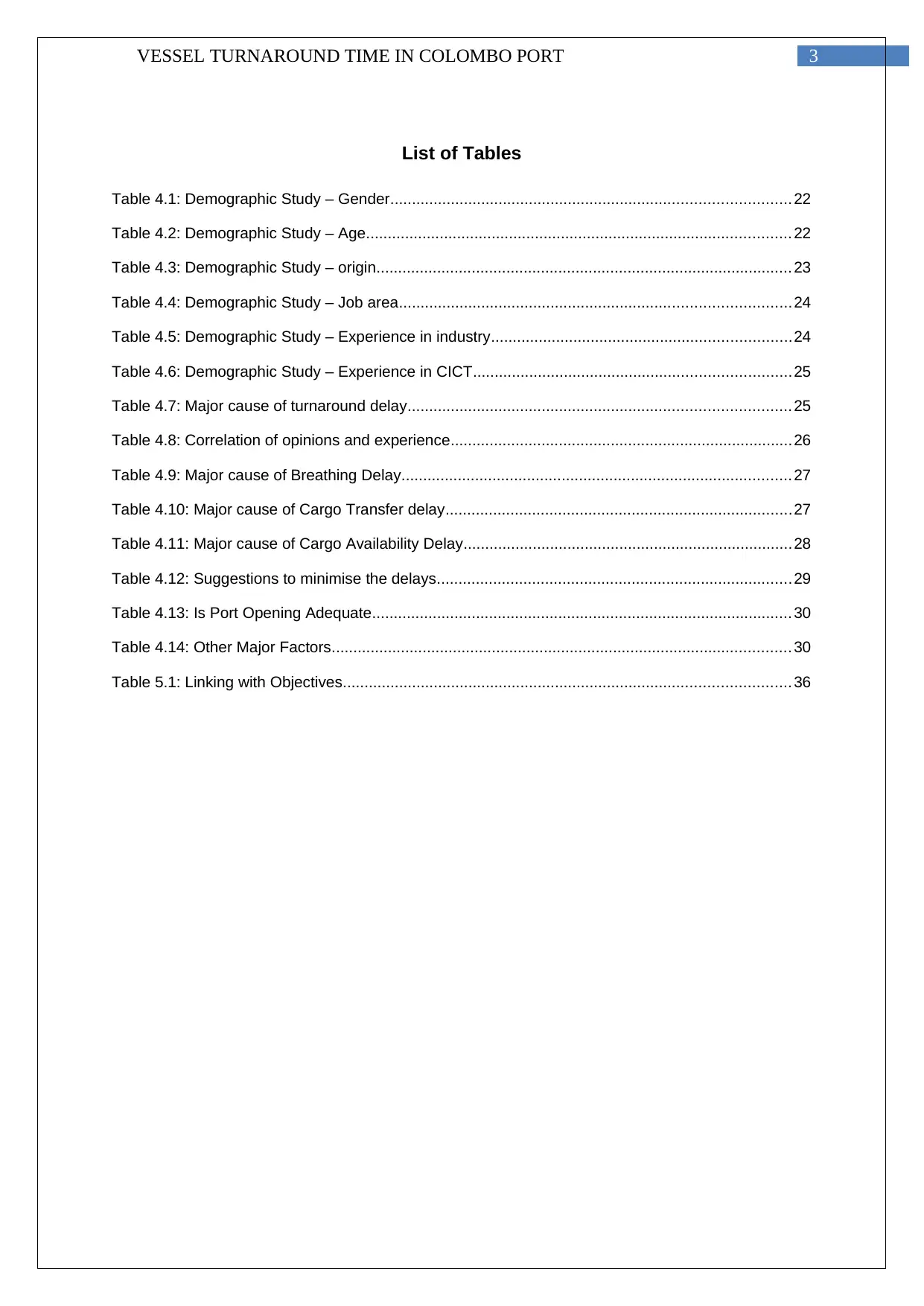
3VESSEL TURNAROUND TIME IN COLOMBO PORT
List of Tables
Table 4.1: Demographic Study – Gender............................................................................................ 22
Table 4.2: Demographic Study – Age.................................................................................................. 22
Table 4.3: Demographic Study – origin................................................................................................ 23
Table 4.4: Demographic Study – Job area..........................................................................................24
Table 4.5: Demographic Study – Experience in industry.....................................................................24
Table 4.6: Demographic Study – Experience in CICT.........................................................................25
Table 4.7: Major cause of turnaround delay........................................................................................25
Table 4.8: Correlation of opinions and experience...............................................................................26
Table 4.9: Major cause of Breathing Delay.......................................................................................... 27
Table 4.10: Major cause of Cargo Transfer delay................................................................................27
Table 4.11: Major cause of Cargo Availability Delay............................................................................28
Table 4.12: Suggestions to minimise the delays..................................................................................29
Table 4.13: Is Port Opening Adequate................................................................................................. 30
Table 4.14: Other Major Factors.......................................................................................................... 30
Table 5.1: Linking with Objectives....................................................................................................... 36
List of Tables
Table 4.1: Demographic Study – Gender............................................................................................ 22
Table 4.2: Demographic Study – Age.................................................................................................. 22
Table 4.3: Demographic Study – origin................................................................................................ 23
Table 4.4: Demographic Study – Job area..........................................................................................24
Table 4.5: Demographic Study – Experience in industry.....................................................................24
Table 4.6: Demographic Study – Experience in CICT.........................................................................25
Table 4.7: Major cause of turnaround delay........................................................................................25
Table 4.8: Correlation of opinions and experience...............................................................................26
Table 4.9: Major cause of Breathing Delay.......................................................................................... 27
Table 4.10: Major cause of Cargo Transfer delay................................................................................27
Table 4.11: Major cause of Cargo Availability Delay............................................................................28
Table 4.12: Suggestions to minimise the delays..................................................................................29
Table 4.13: Is Port Opening Adequate................................................................................................. 30
Table 4.14: Other Major Factors.......................................................................................................... 30
Table 5.1: Linking with Objectives....................................................................................................... 36
Paraphrase This Document
Need a fresh take? Get an instant paraphrase of this document with our AI Paraphraser
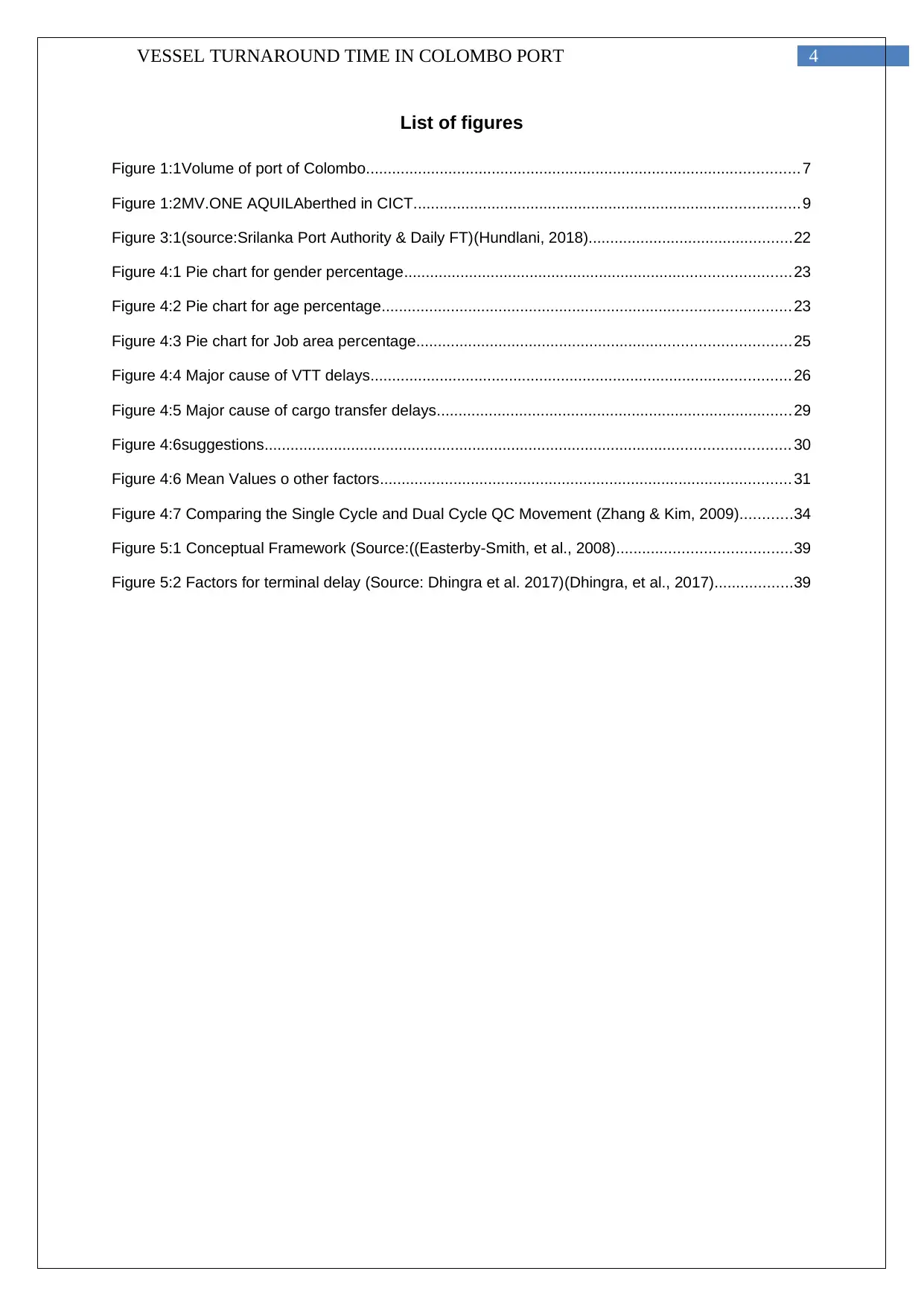
4VESSEL TURNAROUND TIME IN COLOMBO PORT
List of figures
Figure 1:1Volume of port of Colombo.................................................................................................... 7
Figure 1:2MV.ONE AQUILAberthed in CICT.........................................................................................9
Figure 3:1(source:Srilanka Port Authority & Daily FT)(Hundlani, 2018)...............................................22
Figure 4:1 Pie chart for gender percentage.........................................................................................23
Figure 4:2 Pie chart for age percentage.............................................................................................. 23
Figure 4:3 Pie chart for Job area percentage......................................................................................25
Figure 4:4 Major cause of VTT delays................................................................................................. 26
Figure 4:5 Major cause of cargo transfer delays..................................................................................29
Figure 4:6suggestions......................................................................................................................... 30
Figure 4:6 Mean Values o other factors............................................................................................... 31
Figure 4:7 Comparing the Single Cycle and Dual Cycle QC Movement (Zhang & Kim, 2009)............34
Figure 5:1 Conceptual Framework (Source:((Easterby-Smith, et al., 2008)........................................39
Figure 5:2 Factors for terminal delay (Source: Dhingra et al. 2017)(Dhingra, et al., 2017)..................39
List of figures
Figure 1:1Volume of port of Colombo.................................................................................................... 7
Figure 1:2MV.ONE AQUILAberthed in CICT.........................................................................................9
Figure 3:1(source:Srilanka Port Authority & Daily FT)(Hundlani, 2018)...............................................22
Figure 4:1 Pie chart for gender percentage.........................................................................................23
Figure 4:2 Pie chart for age percentage.............................................................................................. 23
Figure 4:3 Pie chart for Job area percentage......................................................................................25
Figure 4:4 Major cause of VTT delays................................................................................................. 26
Figure 4:5 Major cause of cargo transfer delays..................................................................................29
Figure 4:6suggestions......................................................................................................................... 30
Figure 4:6 Mean Values o other factors............................................................................................... 31
Figure 4:7 Comparing the Single Cycle and Dual Cycle QC Movement (Zhang & Kim, 2009)............34
Figure 5:1 Conceptual Framework (Source:((Easterby-Smith, et al., 2008)........................................39
Figure 5:2 Factors for terminal delay (Source: Dhingra et al. 2017)(Dhingra, et al., 2017)..................39
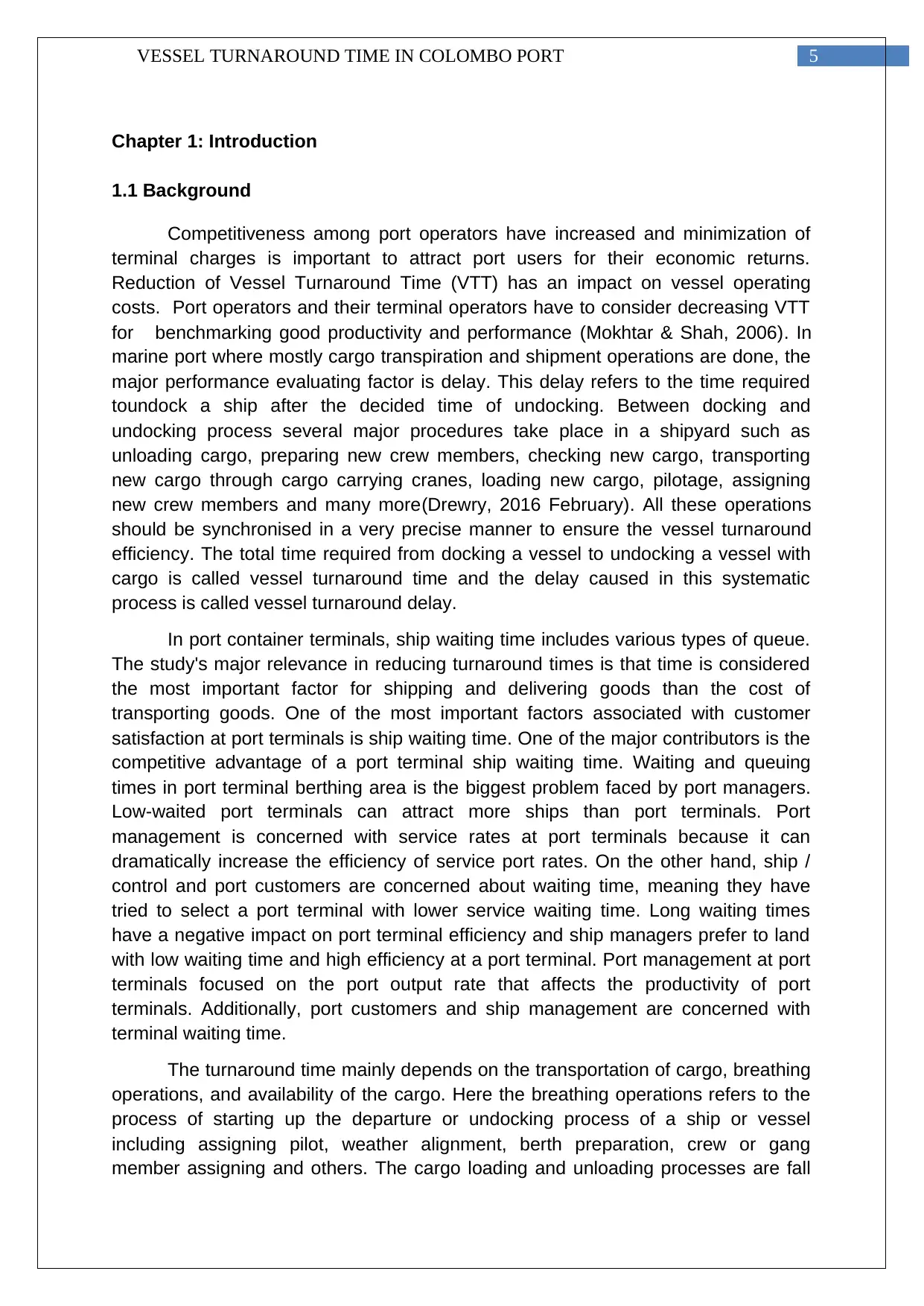
5VESSEL TURNAROUND TIME IN COLOMBO PORT
Chapter 1: Introduction
1.1 Background
Competitiveness among port operators have increased and minimization of
terminal charges is important to attract port users for their economic returns.
Reduction of Vessel Turnaround Time (VTT) has an impact on vessel operating
costs. Port operators and their terminal operators have to consider decreasing VTT
for benchmarking good productivity and performance (Mokhtar & Shah, 2006). In
marine port where mostly cargo transpiration and shipment operations are done, the
major performance evaluating factor is delay. This delay refers to the time required
toundock a ship after the decided time of undocking. Between docking and
undocking process several major procedures take place in a shipyard such as
unloading cargo, preparing new crew members, checking new cargo, transporting
new cargo through cargo carrying cranes, loading new cargo, pilotage, assigning
new crew members and many more(Drewry, 2016 February). All these operations
should be synchronised in a very precise manner to ensure the vessel turnaround
efficiency. The total time required from docking a vessel to undocking a vessel with
cargo is called vessel turnaround time and the delay caused in this systematic
process is called vessel turnaround delay.
In port container terminals, ship waiting time includes various types of queue.
The study's major relevance in reducing turnaround times is that time is considered
the most important factor for shipping and delivering goods than the cost of
transporting goods. One of the most important factors associated with customer
satisfaction at port terminals is ship waiting time. One of the major contributors is the
competitive advantage of a port terminal ship waiting time. Waiting and queuing
times in port terminal berthing area is the biggest problem faced by port managers.
Low-waited port terminals can attract more ships than port terminals. Port
management is concerned with service rates at port terminals because it can
dramatically increase the efficiency of service port rates. On the other hand, ship /
control and port customers are concerned about waiting time, meaning they have
tried to select a port terminal with lower service waiting time. Long waiting times
have a negative impact on port terminal efficiency and ship managers prefer to land
with low waiting time and high efficiency at a port terminal. Port management at port
terminals focused on the port output rate that affects the productivity of port
terminals. Additionally, port customers and ship management are concerned with
terminal waiting time.
The turnaround time mainly depends on the transportation of cargo, breathing
operations, and availability of the cargo. Here the breathing operations refers to the
process of starting up the departure or undocking process of a ship or vessel
including assigning pilot, weather alignment, berth preparation, crew or gang
member assigning and others. The cargo loading and unloading processes are fall
Chapter 1: Introduction
1.1 Background
Competitiveness among port operators have increased and minimization of
terminal charges is important to attract port users for their economic returns.
Reduction of Vessel Turnaround Time (VTT) has an impact on vessel operating
costs. Port operators and their terminal operators have to consider decreasing VTT
for benchmarking good productivity and performance (Mokhtar & Shah, 2006). In
marine port where mostly cargo transpiration and shipment operations are done, the
major performance evaluating factor is delay. This delay refers to the time required
toundock a ship after the decided time of undocking. Between docking and
undocking process several major procedures take place in a shipyard such as
unloading cargo, preparing new crew members, checking new cargo, transporting
new cargo through cargo carrying cranes, loading new cargo, pilotage, assigning
new crew members and many more(Drewry, 2016 February). All these operations
should be synchronised in a very precise manner to ensure the vessel turnaround
efficiency. The total time required from docking a vessel to undocking a vessel with
cargo is called vessel turnaround time and the delay caused in this systematic
process is called vessel turnaround delay.
In port container terminals, ship waiting time includes various types of queue.
The study's major relevance in reducing turnaround times is that time is considered
the most important factor for shipping and delivering goods than the cost of
transporting goods. One of the most important factors associated with customer
satisfaction at port terminals is ship waiting time. One of the major contributors is the
competitive advantage of a port terminal ship waiting time. Waiting and queuing
times in port terminal berthing area is the biggest problem faced by port managers.
Low-waited port terminals can attract more ships than port terminals. Port
management is concerned with service rates at port terminals because it can
dramatically increase the efficiency of service port rates. On the other hand, ship /
control and port customers are concerned about waiting time, meaning they have
tried to select a port terminal with lower service waiting time. Long waiting times
have a negative impact on port terminal efficiency and ship managers prefer to land
with low waiting time and high efficiency at a port terminal. Port management at port
terminals focused on the port output rate that affects the productivity of port
terminals. Additionally, port customers and ship management are concerned with
terminal waiting time.
The turnaround time mainly depends on the transportation of cargo, breathing
operations, and availability of the cargo. Here the breathing operations refers to the
process of starting up the departure or undocking process of a ship or vessel
including assigning pilot, weather alignment, berth preparation, crew or gang
member assigning and others. The cargo loading and unloading processes are fall
⊘ This is a preview!⊘
Do you want full access?
Subscribe today to unlock all pages.

Trusted by 1+ million students worldwide
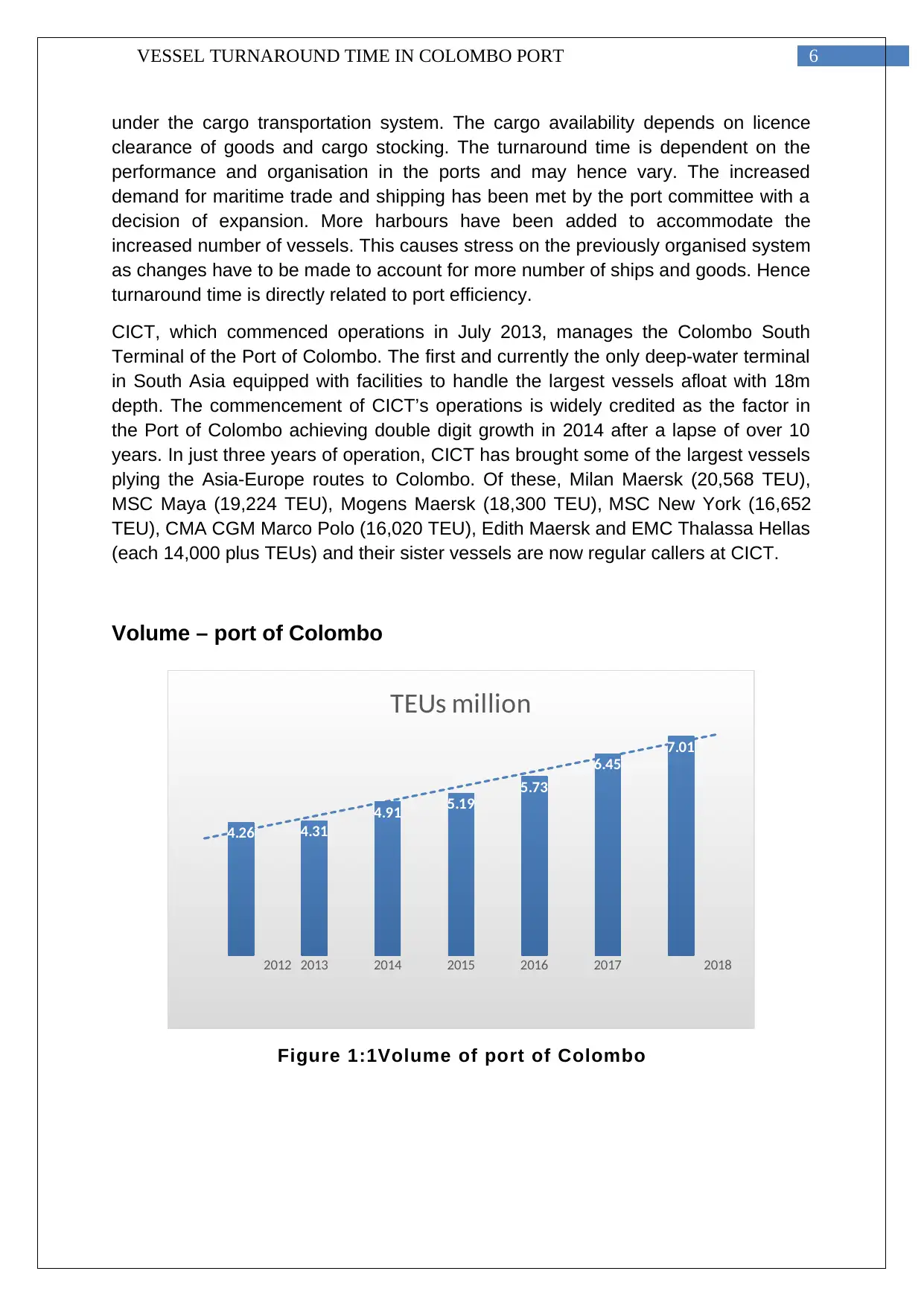
6VESSEL TURNAROUND TIME IN COLOMBO PORT
under the cargo transportation system. The cargo availability depends on licence
clearance of goods and cargo stocking. The turnaround time is dependent on the
performance and organisation in the ports and may hence vary. The increased
demand for maritime trade and shipping has been met by the port committee with a
decision of expansion. More harbours have been added to accommodate the
increased number of vessels. This causes stress on the previously organised system
as changes have to be made to account for more number of ships and goods. Hence
turnaround time is directly related to port efficiency.
CICT, which commenced operations in July 2013, manages the Colombo South
Terminal of the Port of Colombo. The first and currently the only deep-water terminal
in South Asia equipped with facilities to handle the largest vessels afloat with 18m
depth. The commencement of CICT’s operations is widely credited as the factor in
the Port of Colombo achieving double digit growth in 2014 after a lapse of over 10
years. In just three years of operation, CICT has brought some of the largest vessels
plying the Asia-Europe routes to Colombo. Of these, Milan Maersk (20,568 TEU),
MSC Maya (19,224 TEU), Mogens Maersk (18,300 TEU), MSC New York (16,652
TEU), CMA CGM Marco Polo (16,020 TEU), Edith Maersk and EMC Thalassa Hellas
(each 14,000 plus TEUs) and their sister vessels are now regular callers at CICT.
Volume – port of Colombo
2012 2013 2014 2015 2016 2017 2018
4.26 4.31
4.91 5.19
5.73
6.45
7.01
TEUs million
Figure 1:1Volume of port of Colombo
under the cargo transportation system. The cargo availability depends on licence
clearance of goods and cargo stocking. The turnaround time is dependent on the
performance and organisation in the ports and may hence vary. The increased
demand for maritime trade and shipping has been met by the port committee with a
decision of expansion. More harbours have been added to accommodate the
increased number of vessels. This causes stress on the previously organised system
as changes have to be made to account for more number of ships and goods. Hence
turnaround time is directly related to port efficiency.
CICT, which commenced operations in July 2013, manages the Colombo South
Terminal of the Port of Colombo. The first and currently the only deep-water terminal
in South Asia equipped with facilities to handle the largest vessels afloat with 18m
depth. The commencement of CICT’s operations is widely credited as the factor in
the Port of Colombo achieving double digit growth in 2014 after a lapse of over 10
years. In just three years of operation, CICT has brought some of the largest vessels
plying the Asia-Europe routes to Colombo. Of these, Milan Maersk (20,568 TEU),
MSC Maya (19,224 TEU), Mogens Maersk (18,300 TEU), MSC New York (16,652
TEU), CMA CGM Marco Polo (16,020 TEU), Edith Maersk and EMC Thalassa Hellas
(each 14,000 plus TEUs) and their sister vessels are now regular callers at CICT.
Volume – port of Colombo
2012 2013 2014 2015 2016 2017 2018
4.26 4.31
4.91 5.19
5.73
6.45
7.01
TEUs million
Figure 1:1Volume of port of Colombo
Paraphrase This Document
Need a fresh take? Get an instant paraphrase of this document with our AI Paraphraser
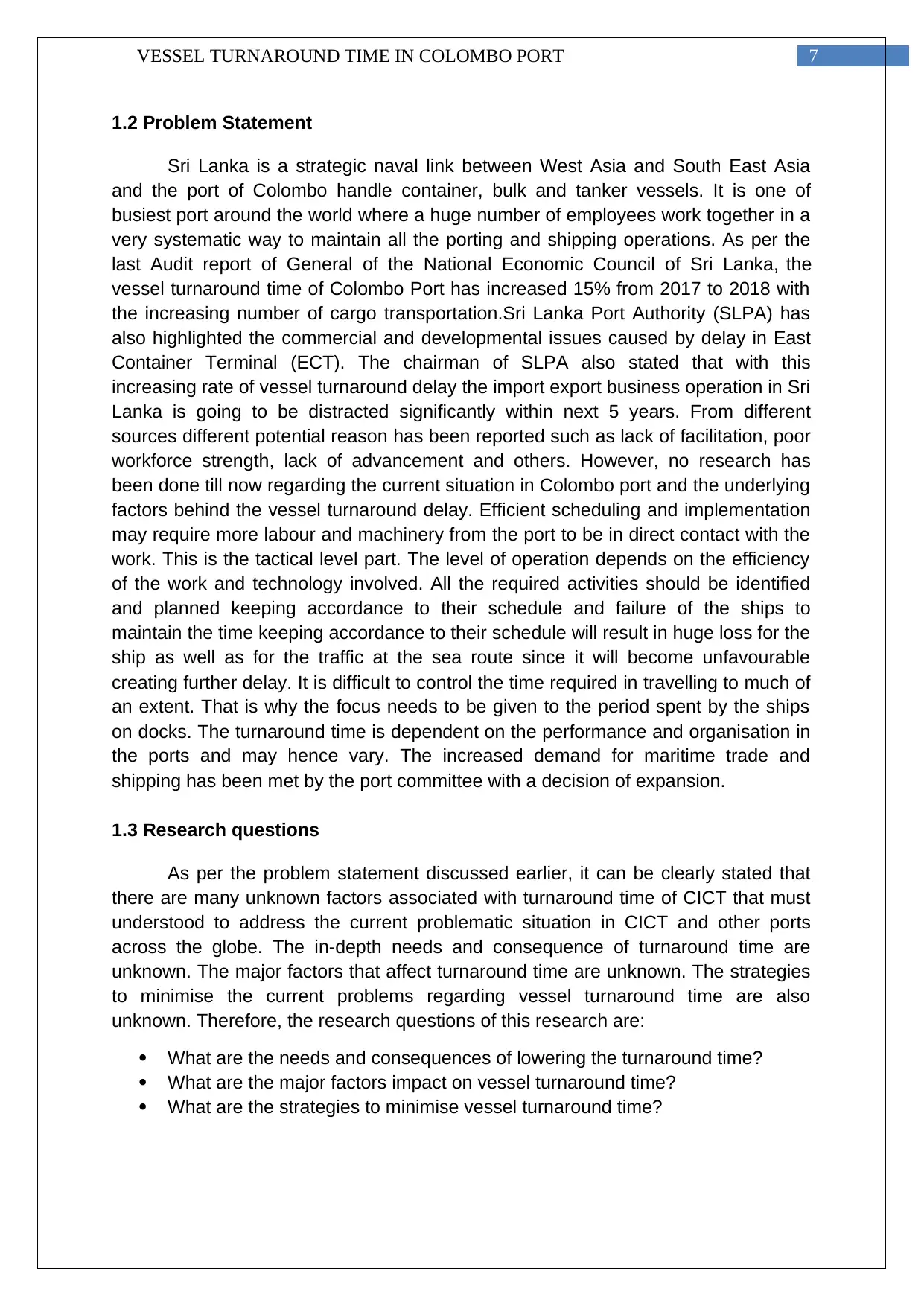
7VESSEL TURNAROUND TIME IN COLOMBO PORT
1.2 Problem Statement
Sri Lanka is a strategic naval link between West Asia and South East Asia
and the port of Colombo handle container, bulk and tanker vessels. It is one of
busiest port around the world where a huge number of employees work together in a
very systematic way to maintain all the porting and shipping operations. As per the
last Audit report of General of the National Economic Council of Sri Lanka, the
vessel turnaround time of Colombo Port has increased 15% from 2017 to 2018 with
the increasing number of cargo transportation.Sri Lanka Port Authority (SLPA) has
also highlighted the commercial and developmental issues caused by delay in East
Container Terminal (ECT). The chairman of SLPA also stated that with this
increasing rate of vessel turnaround delay the import export business operation in Sri
Lanka is going to be distracted significantly within next 5 years. From different
sources different potential reason has been reported such as lack of facilitation, poor
workforce strength, lack of advancement and others. However, no research has
been done till now regarding the current situation in Colombo port and the underlying
factors behind the vessel turnaround delay. Efficient scheduling and implementation
may require more labour and machinery from the port to be in direct contact with the
work. This is the tactical level part. The level of operation depends on the efficiency
of the work and technology involved. All the required activities should be identified
and planned keeping accordance to their schedule and failure of the ships to
maintain the time keeping accordance to their schedule will result in huge loss for the
ship as well as for the traffic at the sea route since it will become unfavourable
creating further delay. It is difficult to control the time required in travelling to much of
an extent. That is why the focus needs to be given to the period spent by the ships
on docks. The turnaround time is dependent on the performance and organisation in
the ports and may hence vary. The increased demand for maritime trade and
shipping has been met by the port committee with a decision of expansion.
1.3 Research questions
As per the problem statement discussed earlier, it can be clearly stated that
there are many unknown factors associated with turnaround time of CICT that must
understood to address the current problematic situation in CICT and other ports
across the globe. The in-depth needs and consequence of turnaround time are
unknown. The major factors that affect turnaround time are unknown. The strategies
to minimise the current problems regarding vessel turnaround time are also
unknown. Therefore, the research questions of this research are:
What are the needs and consequences of lowering the turnaround time?
What are the major factors impact on vessel turnaround time?
What are the strategies to minimise vessel turnaround time?
1.2 Problem Statement
Sri Lanka is a strategic naval link between West Asia and South East Asia
and the port of Colombo handle container, bulk and tanker vessels. It is one of
busiest port around the world where a huge number of employees work together in a
very systematic way to maintain all the porting and shipping operations. As per the
last Audit report of General of the National Economic Council of Sri Lanka, the
vessel turnaround time of Colombo Port has increased 15% from 2017 to 2018 with
the increasing number of cargo transportation.Sri Lanka Port Authority (SLPA) has
also highlighted the commercial and developmental issues caused by delay in East
Container Terminal (ECT). The chairman of SLPA also stated that with this
increasing rate of vessel turnaround delay the import export business operation in Sri
Lanka is going to be distracted significantly within next 5 years. From different
sources different potential reason has been reported such as lack of facilitation, poor
workforce strength, lack of advancement and others. However, no research has
been done till now regarding the current situation in Colombo port and the underlying
factors behind the vessel turnaround delay. Efficient scheduling and implementation
may require more labour and machinery from the port to be in direct contact with the
work. This is the tactical level part. The level of operation depends on the efficiency
of the work and technology involved. All the required activities should be identified
and planned keeping accordance to their schedule and failure of the ships to
maintain the time keeping accordance to their schedule will result in huge loss for the
ship as well as for the traffic at the sea route since it will become unfavourable
creating further delay. It is difficult to control the time required in travelling to much of
an extent. That is why the focus needs to be given to the period spent by the ships
on docks. The turnaround time is dependent on the performance and organisation in
the ports and may hence vary. The increased demand for maritime trade and
shipping has been met by the port committee with a decision of expansion.
1.3 Research questions
As per the problem statement discussed earlier, it can be clearly stated that
there are many unknown factors associated with turnaround time of CICT that must
understood to address the current problematic situation in CICT and other ports
across the globe. The in-depth needs and consequence of turnaround time are
unknown. The major factors that affect turnaround time are unknown. The strategies
to minimise the current problems regarding vessel turnaround time are also
unknown. Therefore, the research questions of this research are:
What are the needs and consequences of lowering the turnaround time?
What are the major factors impact on vessel turnaround time?
What are the strategies to minimise vessel turnaround time?

8VESSEL TURNAROUND TIME IN COLOMBO PORT
1.4 Aims and objectives
The aim of the project is to study the impacting factors of low turnaround time
in the Colombo Port. The Terminal chosen for the study was the Colombo
International Container Terminals (CICT) which is the only deep-water terminal in
South Asia equipped with facilities to handle any kind of larger vessels. This will be
conducted over three months.
To assess the need and consequence of lowering the turnaround time
To identify the factors that have an impact on vessel turnaround time
To find the ways in which vessel turnaround time can be minimised
1.5 Research Structure
This research consists of 5 major chapters namely the introduction, literature
review, methods, results and conclusion respectively. In introduction section the
research rationale with aims and objectives have been discussed. In literature review
the secondary data has been collected and presented in thematic format. In the
method section the data collection and data analysis tool with ethical aspects have
been presented. In the result section the statistical analysis has been done to
formulate the results accordingly. In conclusion part the implications of the findings
have been presented considering the research objectives and further scope.
Figure 1:2MV.ONE AQUILAberthed in CICT.
1.4 Aims and objectives
The aim of the project is to study the impacting factors of low turnaround time
in the Colombo Port. The Terminal chosen for the study was the Colombo
International Container Terminals (CICT) which is the only deep-water terminal in
South Asia equipped with facilities to handle any kind of larger vessels. This will be
conducted over three months.
To assess the need and consequence of lowering the turnaround time
To identify the factors that have an impact on vessel turnaround time
To find the ways in which vessel turnaround time can be minimised
1.5 Research Structure
This research consists of 5 major chapters namely the introduction, literature
review, methods, results and conclusion respectively. In introduction section the
research rationale with aims and objectives have been discussed. In literature review
the secondary data has been collected and presented in thematic format. In the
method section the data collection and data analysis tool with ethical aspects have
been presented. In the result section the statistical analysis has been done to
formulate the results accordingly. In conclusion part the implications of the findings
have been presented considering the research objectives and further scope.
Figure 1:2MV.ONE AQUILAberthed in CICT.
⊘ This is a preview!⊘
Do you want full access?
Subscribe today to unlock all pages.

Trusted by 1+ million students worldwide
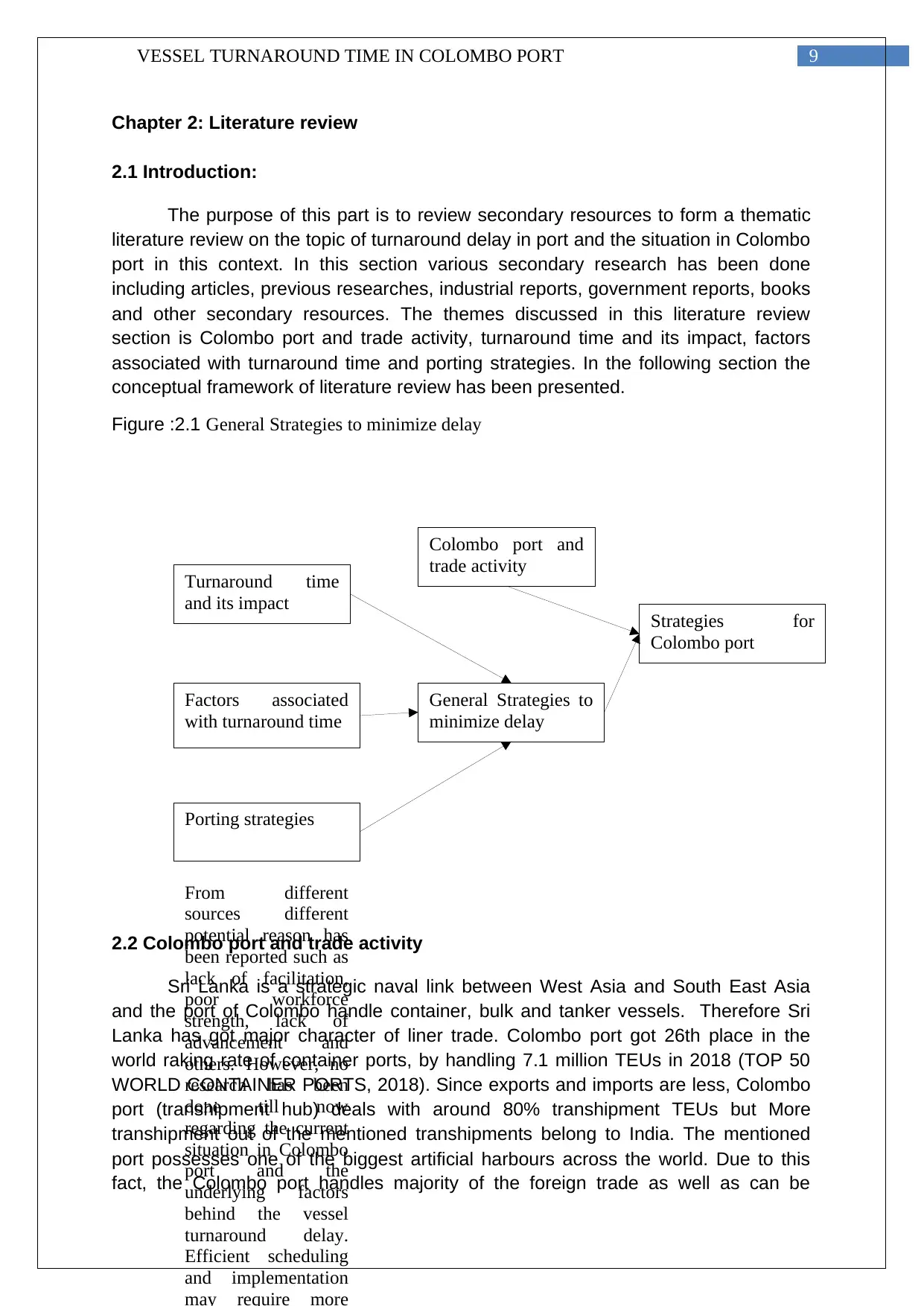
9VESSEL TURNAROUND TIME IN COLOMBO PORT
Colombo port and
trade activity
Turnaround time
and its impact
Factors associated
with turnaround time
From different
sources different
potential reason has
been reported such as
lack of facilitation,
poor workforce
strength, lack of
advancement and
others. However, no
research has been
done till now
regarding the current
situation in Colombo
port and the
underlying factors
behind the vessel
turnaround delay.
Efficient scheduling
and implementation
may require more
Porting strategies
General Strategies to
minimize delay
Strategies for
Colombo port
Chapter 2: Literature review
2.1 Introduction:
The purpose of this part is to review secondary resources to form a thematic
literature review on the topic of turnaround delay in port and the situation in Colombo
port in this context. In this section various secondary research has been done
including articles, previous researches, industrial reports, government reports, books
and other secondary resources. The themes discussed in this literature review
section is Colombo port and trade activity, turnaround time and its impact, factors
associated with turnaround time and porting strategies. In the following section the
conceptual framework of literature review has been presented.
Figure :2.1 General Strategies to minimize delay
2.2 Colombo port and trade activity
Sri Lanka is a strategic naval link between West Asia and South East Asia
and the port of Colombo handle container, bulk and tanker vessels. Therefore Sri
Lanka has got major character of liner trade. Colombo port got 26th place in the
world raking rate of container ports, by handling 7.1 million TEUs in 2018 (TOP 50
WORLD CONTAINER PORTS, 2018). Since exports and imports are less, Colombo
port (transhipment hub) deals with around 80% transhipment TEUs but More
transhipment out of the mentioned transhipments belong to India. The mentioned
port possesses one of the biggest artificial harbours across the world. Due to this
fact, the Colombo port handles majority of the foreign trade as well as can be
Colombo port and
trade activity
Turnaround time
and its impact
Factors associated
with turnaround time
From different
sources different
potential reason has
been reported such as
lack of facilitation,
poor workforce
strength, lack of
advancement and
others. However, no
research has been
done till now
regarding the current
situation in Colombo
port and the
underlying factors
behind the vessel
turnaround delay.
Efficient scheduling
and implementation
may require more
Porting strategies
General Strategies to
minimize delay
Strategies for
Colombo port
Chapter 2: Literature review
2.1 Introduction:
The purpose of this part is to review secondary resources to form a thematic
literature review on the topic of turnaround delay in port and the situation in Colombo
port in this context. In this section various secondary research has been done
including articles, previous researches, industrial reports, government reports, books
and other secondary resources. The themes discussed in this literature review
section is Colombo port and trade activity, turnaround time and its impact, factors
associated with turnaround time and porting strategies. In the following section the
conceptual framework of literature review has been presented.
Figure :2.1 General Strategies to minimize delay
2.2 Colombo port and trade activity
Sri Lanka is a strategic naval link between West Asia and South East Asia
and the port of Colombo handle container, bulk and tanker vessels. Therefore Sri
Lanka has got major character of liner trade. Colombo port got 26th place in the
world raking rate of container ports, by handling 7.1 million TEUs in 2018 (TOP 50
WORLD CONTAINER PORTS, 2018). Since exports and imports are less, Colombo
port (transhipment hub) deals with around 80% transhipment TEUs but More
transhipment out of the mentioned transhipments belong to India. The mentioned
port possesses one of the biggest artificial harbours across the world. Due to this
fact, the Colombo port handles majority of the foreign trade as well as can be
Paraphrase This Document
Need a fresh take? Get an instant paraphrase of this document with our AI Paraphraser
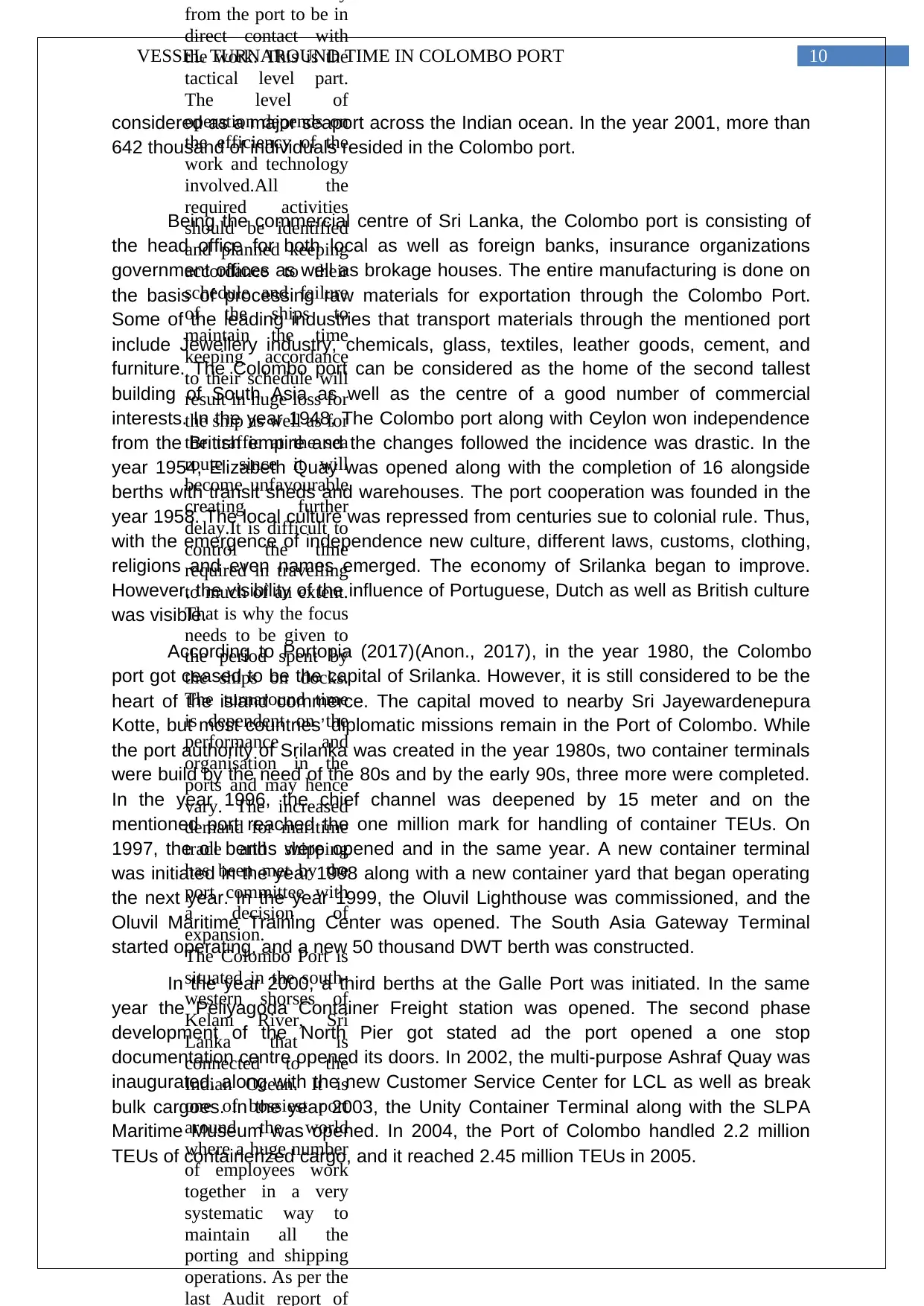
10VESSEL TURNAROUND TIME IN COLOMBO PORT
from the port to be in
direct contact with
the work. This is the
tactical level part.
The level of
operation depends on
the efficiency of the
work and technology
involved.All the
required activities
should be identified
and planned keeping
accordance to their
schedule and failure
of the ships to
maintain the time
keeping accordance
to their schedule will
result in huge loss for
the ship as well as for
the traffic at the sea
route since it will
become unfavourable
creating further
delay.It is difficult to
control the time
required in travelling
to much of an extent.
That is why the focus
needs to be given to
the period spent by
the ships on docks.
The turnaround time
is dependent on the
performance and
organisation in the
ports and may hence
vary. The increased
demand for maritime
trade and shipping
has been met by the
port committee with
a decision of
expansion.
The Colombo Port is
situated in the south-
western shorses of
Kelani River, Sri
Lanka that is
connected to the
Indian Ocean. It is
one of bossiest port
around the world
where a huge number
of employees work
together in a very
systematic way to
maintain all the
porting and shipping
operations. As per the
last Audit report of
considered as a major seaport across the Indian ocean. In the year 2001, more than
642 thousand of individuals resided in the Colombo port.
Being the commercial centre of Sri Lanka, the Colombo port is consisting of
the head office for both local as well as foreign banks, insurance organizations
government offices as well as brokage houses. The entire manufacturing is done on
the basis of processing raw materials for exportation through the Colombo Port.
Some of the leading industries that transport materials through the mentioned port
include Jewellery industry, chemicals, glass, textiles, leather goods, cement, and
furniture. The Colombo port can be considered as the home of the second tallest
building of South Asia as well as the centre of a good number of commercial
interests. In the year 1948, The Colombo port along with Ceylon won independence
from the British empire and the changes followed the incidence was drastic. In the
year 1954, Elizabeth Quay was opened along with the completion of 16 alongside
berths with transit sheds and warehouses. The port cooperation was founded in the
year 1958. The local culture was repressed from centuries sue to colonial rule. Thus,
with the emergence of independence new culture, different laws, customs, clothing,
religions and even names emerged. The economy of Srilanka began to improve.
However, the visibility of the influence of Portuguese, Dutch as well as British culture
was visible.
According to Portopia (2017)(Anon., 2017), in the year 1980, the Colombo
port got ceased to be the capital of Srilanka. However, it is still considered to be the
heart of the island commerce. The capital moved to nearby Sri Jayewardenepura
Kotte, but most countries’ diplomatic missions remain in the Port of Colombo. While
the port authority of Srilanka was created in the year 1980s, two container terminals
were build by the need of the 80s and by the early 90s, three more were completed.
In the year 1996, the chief channel was deepened by 15 meter and on the
mentioned port reached the one million mark for handling of container TEUs. On
1997, the oil berths were opened and in the same year. A new container terminal
was initiated in the year 1998 along with a new container yard that began operating
the next year. In the year 1999, the Oluvil Lighthouse was commissioned, and the
Oluvil Maritime Training Center was opened. The South Asia Gateway Terminal
started operating, and a new 50 thousand DWT berth was constructed.
In the year 2000, a third berths at the Galle Port was initiated. In the same
year the Peliyagoda Container Freight station was opened. The second phase
development of the North Pier got stated ad the port opened a one stop
documentation centre opened its doors. In 2002, the multi-purpose Ashraf Quay was
inaugurated, along with the new Customer Service Center for LCL as well as break
bulk cargoes. In the year 2003, the Unity Container Terminal along with the SLPA
Maritime Museum was opened. In 2004, the Port of Colombo handled 2.2 million
TEUs of containerized cargo, and it reached 2.45 million TEUs in 2005.
from the port to be in
direct contact with
the work. This is the
tactical level part.
The level of
operation depends on
the efficiency of the
work and technology
involved.All the
required activities
should be identified
and planned keeping
accordance to their
schedule and failure
of the ships to
maintain the time
keeping accordance
to their schedule will
result in huge loss for
the ship as well as for
the traffic at the sea
route since it will
become unfavourable
creating further
delay.It is difficult to
control the time
required in travelling
to much of an extent.
That is why the focus
needs to be given to
the period spent by
the ships on docks.
The turnaround time
is dependent on the
performance and
organisation in the
ports and may hence
vary. The increased
demand for maritime
trade and shipping
has been met by the
port committee with
a decision of
expansion.
The Colombo Port is
situated in the south-
western shorses of
Kelani River, Sri
Lanka that is
connected to the
Indian Ocean. It is
one of bossiest port
around the world
where a huge number
of employees work
together in a very
systematic way to
maintain all the
porting and shipping
operations. As per the
last Audit report of
considered as a major seaport across the Indian ocean. In the year 2001, more than
642 thousand of individuals resided in the Colombo port.
Being the commercial centre of Sri Lanka, the Colombo port is consisting of
the head office for both local as well as foreign banks, insurance organizations
government offices as well as brokage houses. The entire manufacturing is done on
the basis of processing raw materials for exportation through the Colombo Port.
Some of the leading industries that transport materials through the mentioned port
include Jewellery industry, chemicals, glass, textiles, leather goods, cement, and
furniture. The Colombo port can be considered as the home of the second tallest
building of South Asia as well as the centre of a good number of commercial
interests. In the year 1948, The Colombo port along with Ceylon won independence
from the British empire and the changes followed the incidence was drastic. In the
year 1954, Elizabeth Quay was opened along with the completion of 16 alongside
berths with transit sheds and warehouses. The port cooperation was founded in the
year 1958. The local culture was repressed from centuries sue to colonial rule. Thus,
with the emergence of independence new culture, different laws, customs, clothing,
religions and even names emerged. The economy of Srilanka began to improve.
However, the visibility of the influence of Portuguese, Dutch as well as British culture
was visible.
According to Portopia (2017)(Anon., 2017), in the year 1980, the Colombo
port got ceased to be the capital of Srilanka. However, it is still considered to be the
heart of the island commerce. The capital moved to nearby Sri Jayewardenepura
Kotte, but most countries’ diplomatic missions remain in the Port of Colombo. While
the port authority of Srilanka was created in the year 1980s, two container terminals
were build by the need of the 80s and by the early 90s, three more were completed.
In the year 1996, the chief channel was deepened by 15 meter and on the
mentioned port reached the one million mark for handling of container TEUs. On
1997, the oil berths were opened and in the same year. A new container terminal
was initiated in the year 1998 along with a new container yard that began operating
the next year. In the year 1999, the Oluvil Lighthouse was commissioned, and the
Oluvil Maritime Training Center was opened. The South Asia Gateway Terminal
started operating, and a new 50 thousand DWT berth was constructed.
In the year 2000, a third berths at the Galle Port was initiated. In the same
year the Peliyagoda Container Freight station was opened. The second phase
development of the North Pier got stated ad the port opened a one stop
documentation centre opened its doors. In 2002, the multi-purpose Ashraf Quay was
inaugurated, along with the new Customer Service Center for LCL as well as break
bulk cargoes. In the year 2003, the Unity Container Terminal along with the SLPA
Maritime Museum was opened. In 2004, the Port of Colombo handled 2.2 million
TEUs of containerized cargo, and it reached 2.45 million TEUs in 2005.
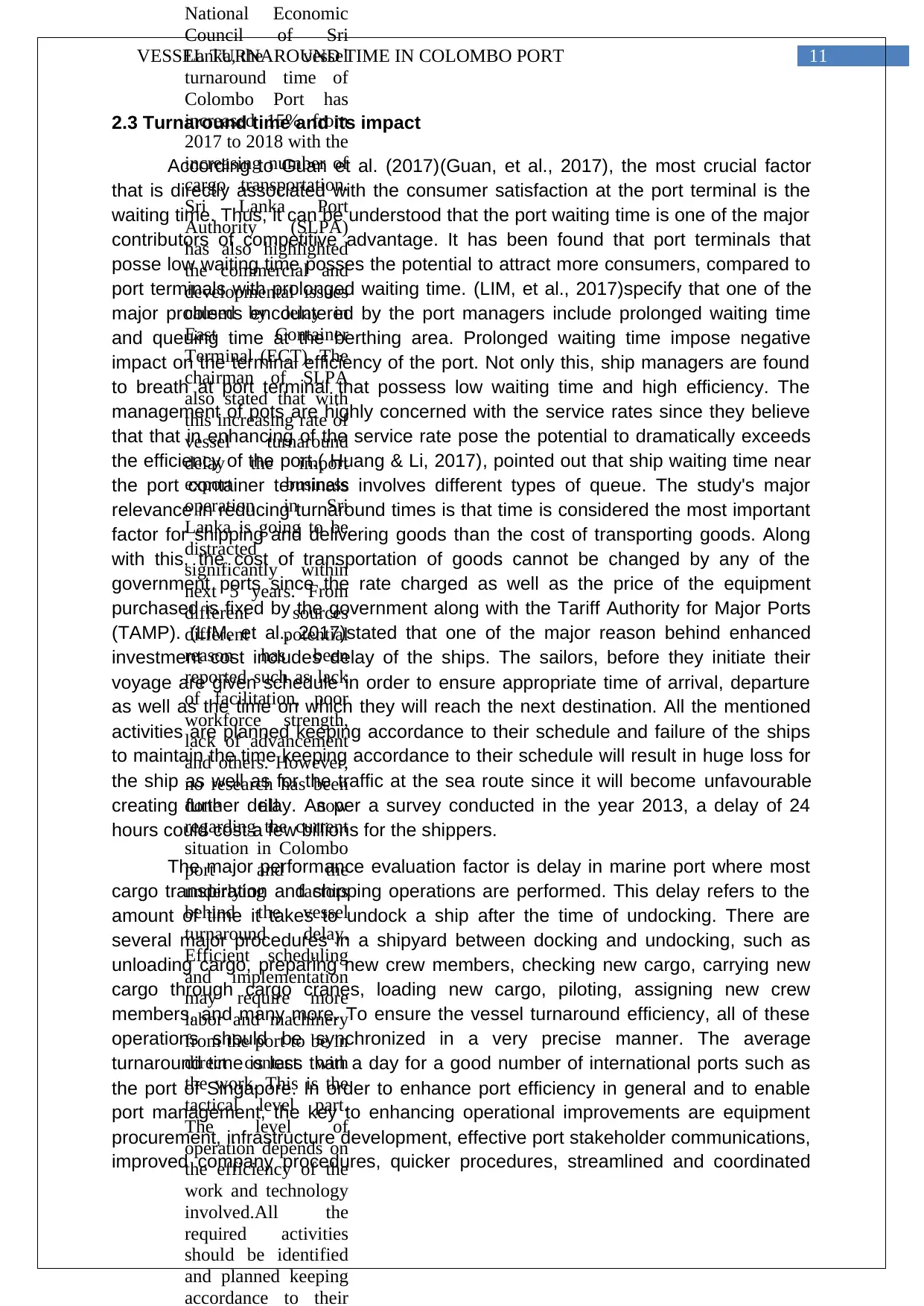
11VESSEL TURNAROUND TIME IN COLOMBO PORT
National Economic
Council of Sri
Lanka, the vessel
turnaround time of
Colombo Port has
increased 15% from
2017 to 2018 with the
increasing number of
cargo transportation.
Sri Lanka Port
Authority (SLPA)
has also highlighted
the commercial and
developmental issues
caused by delay in
East Container
Terminal (ECT). The
chairman of SLPA
also stated that with
this increasing rate of
vessel turnaround
delay the import
export business
operation in Sri
Lanka is going to be
distracted
significantly within
next 5 years. From
different sources
different potential
reason has been
reported such as lack
of facilitation, poor
workforce strength,
lack of advancement
and others. However,
no research has been
done till now
regarding the current
situation in Colombo
port and the
underlying factors
behind the vessel
turnaround delay.
Efficient scheduling
and implementation
may require more
labor and machinery
from the port to be in
direct contact with
the work. This is the
tactical level part.
The level of
operation depends on
the efficiency of the
work and technology
involved.All the
required activities
should be identified
and planned keeping
accordance to their
2.3 Turnaround time and its impact
According to Guan et al. (2017)(Guan, et al., 2017), the most crucial factor
that is directly associated with the consumer satisfaction at the port terminal is the
waiting time. Thus, it can be understood that the port waiting time is one of the major
contributors of competitive advantage. It has been found that port terminals that
posse low waiting time posses the potential to attract more consumers, compared to
port terminals with prolonged waiting time. (LIM, et al., 2017)specify that one of the
major problems encountered by the port managers include prolonged waiting time
and queuing time at the berthing area. Prolonged waiting time impose negative
impact on the terminal efficiency of the port. Not only this, ship managers are found
to breath at port terminal that possess low waiting time and high efficiency. The
management of pots are highly concerned with the service rates since they believe
that that in enhancing of the service rate pose the potential to dramatically exceeds
the efficiency of the port.( Huang & Li, 2017), pointed out that ship waiting time near
the port container terminals involves different types of queue. The study's major
relevance in reducing turnaround times is that time is considered the most important
factor for shipping and delivering goods than the cost of transporting goods. Along
with this, the cost of transportation of goods cannot be changed by any of the
government ports since the rate charged as well as the price of the equipment
purchased is fixed by the government along with the Tariff Authority for Major Ports
(TAMP). (LIM, et al., 2017)stated that one of the major reason behind enhanced
investment cost includes delay of the ships. The sailors, before they initiate their
voyage are given schedule in order to ensure appropriate time of arrival, departure
as well as the time on which they will reach the next destination. All the mentioned
activities are planned keeping accordance to their schedule and failure of the ships
to maintain the time keeping accordance to their schedule will result in huge loss for
the ship as well as for the traffic at the sea route since it will become unfavourable
creating further delay. As per a survey conducted in the year 2013, a delay of 24
hours could cost a few billions for the shippers.
The major performance evaluation factor is delay in marine port where most
cargo transpiration and shipping operations are performed. This delay refers to the
amount of time it takes to undock a ship after the time of undocking. There are
several major procedures in a shipyard between docking and undocking, such as
unloading cargo, preparing new crew members, checking new cargo, carrying new
cargo through cargo cranes, loading new cargo, piloting, assigning new crew
members, and many more. To ensure the vessel turnaround efficiency, all of these
operations should be synchronized in a very precise manner. The average
turnaround time is less than a day for a good number of international ports such as
the port of Singapore. In order to enhance port efficiency in general and to enable
port management, the key to enhancing operational improvements are equipment
procurement, infrastructure development, effective port stakeholder communications,
improved company procedures, quicker procedures, streamlined and coordinated
National Economic
Council of Sri
Lanka, the vessel
turnaround time of
Colombo Port has
increased 15% from
2017 to 2018 with the
increasing number of
cargo transportation.
Sri Lanka Port
Authority (SLPA)
has also highlighted
the commercial and
developmental issues
caused by delay in
East Container
Terminal (ECT). The
chairman of SLPA
also stated that with
this increasing rate of
vessel turnaround
delay the import
export business
operation in Sri
Lanka is going to be
distracted
significantly within
next 5 years. From
different sources
different potential
reason has been
reported such as lack
of facilitation, poor
workforce strength,
lack of advancement
and others. However,
no research has been
done till now
regarding the current
situation in Colombo
port and the
underlying factors
behind the vessel
turnaround delay.
Efficient scheduling
and implementation
may require more
labor and machinery
from the port to be in
direct contact with
the work. This is the
tactical level part.
The level of
operation depends on
the efficiency of the
work and technology
involved.All the
required activities
should be identified
and planned keeping
accordance to their
2.3 Turnaround time and its impact
According to Guan et al. (2017)(Guan, et al., 2017), the most crucial factor
that is directly associated with the consumer satisfaction at the port terminal is the
waiting time. Thus, it can be understood that the port waiting time is one of the major
contributors of competitive advantage. It has been found that port terminals that
posse low waiting time posses the potential to attract more consumers, compared to
port terminals with prolonged waiting time. (LIM, et al., 2017)specify that one of the
major problems encountered by the port managers include prolonged waiting time
and queuing time at the berthing area. Prolonged waiting time impose negative
impact on the terminal efficiency of the port. Not only this, ship managers are found
to breath at port terminal that possess low waiting time and high efficiency. The
management of pots are highly concerned with the service rates since they believe
that that in enhancing of the service rate pose the potential to dramatically exceeds
the efficiency of the port.( Huang & Li, 2017), pointed out that ship waiting time near
the port container terminals involves different types of queue. The study's major
relevance in reducing turnaround times is that time is considered the most important
factor for shipping and delivering goods than the cost of transporting goods. Along
with this, the cost of transportation of goods cannot be changed by any of the
government ports since the rate charged as well as the price of the equipment
purchased is fixed by the government along with the Tariff Authority for Major Ports
(TAMP). (LIM, et al., 2017)stated that one of the major reason behind enhanced
investment cost includes delay of the ships. The sailors, before they initiate their
voyage are given schedule in order to ensure appropriate time of arrival, departure
as well as the time on which they will reach the next destination. All the mentioned
activities are planned keeping accordance to their schedule and failure of the ships
to maintain the time keeping accordance to their schedule will result in huge loss for
the ship as well as for the traffic at the sea route since it will become unfavourable
creating further delay. As per a survey conducted in the year 2013, a delay of 24
hours could cost a few billions for the shippers.
The major performance evaluation factor is delay in marine port where most
cargo transpiration and shipping operations are performed. This delay refers to the
amount of time it takes to undock a ship after the time of undocking. There are
several major procedures in a shipyard between docking and undocking, such as
unloading cargo, preparing new crew members, checking new cargo, carrying new
cargo through cargo cranes, loading new cargo, piloting, assigning new crew
members, and many more. To ensure the vessel turnaround efficiency, all of these
operations should be synchronized in a very precise manner. The average
turnaround time is less than a day for a good number of international ports such as
the port of Singapore. In order to enhance port efficiency in general and to enable
port management, the key to enhancing operational improvements are equipment
procurement, infrastructure development, effective port stakeholder communications,
improved company procedures, quicker procedures, streamlined and coordinated
⊘ This is a preview!⊘
Do you want full access?
Subscribe today to unlock all pages.

Trusted by 1+ million students worldwide
1 out of 47
Related Documents
Your All-in-One AI-Powered Toolkit for Academic Success.
+13062052269
info@desklib.com
Available 24*7 on WhatsApp / Email
![[object Object]](/_next/static/media/star-bottom.7253800d.svg)
Unlock your academic potential
Copyright © 2020–2025 A2Z Services. All Rights Reserved. Developed and managed by ZUCOL.





